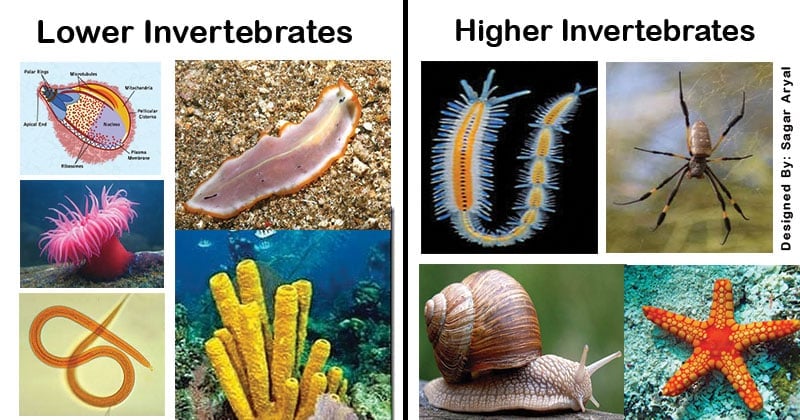The invertebrates are usually classified as Lower Invertebrates and Higher Invertebrates.
Interesting Science Videos
Lower Invertebrates
- The lower invertebrates are simple in body organization.
- They are generally small in size.
- These are thought to have originated in the main lines of evolution, near the base of the phylogenetic tree of Animal kingdom.
- Lower Invertebrates includes Protozoa, Porifera, Coelenterata (Cnidaria), Platyhelminthes and Nematoda.
Higher Invertebrates
- They possess a complex body organization.
- They are generally larger in size.
- These occupy a higher position in the phylogenetic tree of Animal kingdom.
- Higher Invertebrates include Mollusca, Annelida, Arthropoda, and Echinodermata.

On the basis of some important features, there are some differences between lower and higher invertebrates as shown below:
Table 1: Differences between Lower Invertebrates and Higher Invertebrates
S.N. |
Characteristics |
Lower Invertebrates |
Higher Invertebrates |
| 1. | Size | Smaller in size | Larger in size |
| 2. | Body organization | Body organization simple | Body organization complex |
| 3. | Symmetry | Radial, biradial or no symmetry | Bilateral symmetry |
| 4. | Germ Layers | Germ layers wanting or 2 or 3 germ layers | Three germ layers present |
| 5. | Coelom | No Coelom or a pseudo-coelom | True Coelom |
| 6. | Mouth and Anus | Generally, no separate mouth and anus | Mouth and Anus are separate |
| 7. | Muscular Gut | Absent | Present |
| 8. | Blood Vascular System | Not well developed | Well developed |
References
- Kotpal RL. 2017. Modern Text Book of Zoology- Invertebrates. 11th Edition. Rastogi Publications.
- Jordan EL and Verma PS. 2018. Invertebrate Zoology. 14th Edition. S Chand Publishing.

Great job!!